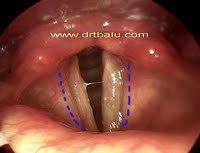Spasmodic dysphonia current management trends
Introduction:
Spasmodic dysphonia is commonly of adductor type. This is infact a focal form of adult onset laryngeal dystonia caused by excessive adduction due to adductor spasm of vocal folds.
Character of voice in these patients:
Voice in these patients is strained and husky. It shows tremors and involuntary pitch breaks. The quality of voice in these patients deteriorates during stressful speaking conditions. This voice causes psychologically a negative impact on the patient's quality of life leading to social isolation.
Etiopathogenesis:
This condition is assumed to be caused by a chronic neurologic disorder of central motor processing, causing action induced muscle spasms of larynx.
Management:
This type of dysphonia is highly resistant to voice therapy.
Various surgical modalities like recurrent laryngeal nerve section and Type II thyroplasty have high failure rates. These surgical procedures are fraught with increased incidence of complications.
Botox (Botulinum toxin) injections into the thyroarytenoid muscle provides variable relief with no side effects. Voice improvement lasts only for a limited period of time lasting for weeks - months. Botox causes chemical denervation of thyroarytenoid muscle by interfering with release of acetyl choline at motor end plates.
Laser thyroarytenoid myoneurectomy:
This surgery is performed under general anesthesia.
Co2 laser with 10 watts intensity is used in continuous mode, slightly defocused.
Ventricular bands are partially resected on both sides exposing the vocal cords completely.
The middle and posterior third of thryoarytenoid muscles are excised / vaporized (if laser is used).
Care should be taken to prevent damage to vocalis muscles.

